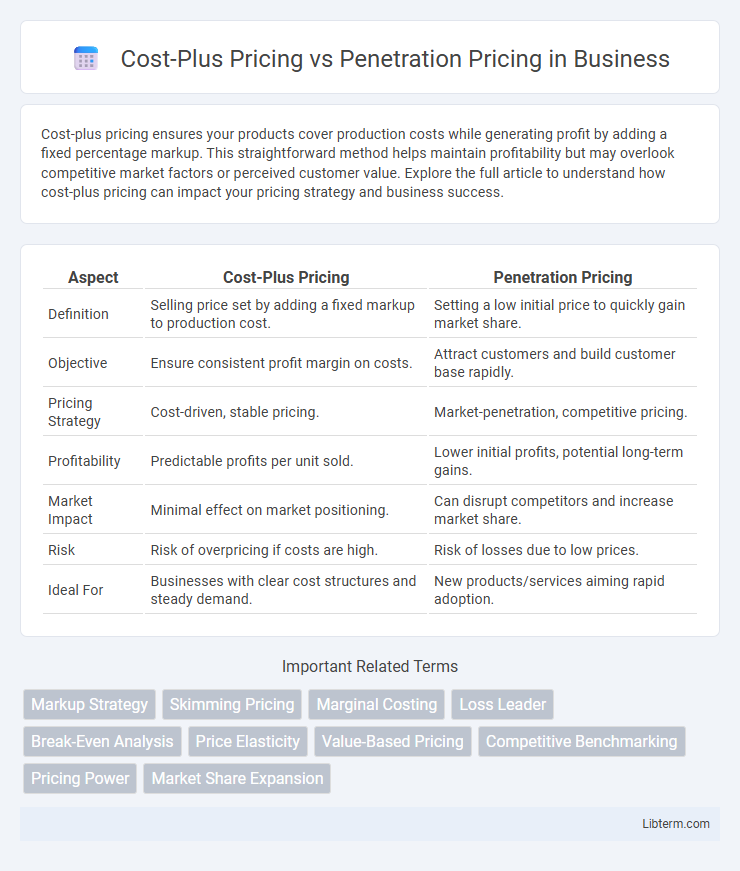Cost-plus pricing ensures your products cover production costs while generating profit by adding a fixed percentage markup. This straightforward method helps maintain profitability but may overlook competitive market factors or perceived customer value. Explore the full article to understand how cost-plus pricing can impact your pricing strategy and business success.
Table of Comparison
| Aspect | Cost-Plus Pricing | Penetration Pricing |
|---|---|---|
| Definition | Selling price set by adding a fixed markup to production cost. | Setting a low initial price to quickly gain market share. |
| Objective | Ensure consistent profit margin on costs. | Attract customers and build customer base rapidly. |
| Pricing Strategy | Cost-driven, stable pricing. | Market-penetration, competitive pricing. |
| Profitability | Predictable profits per unit sold. | Lower initial profits, potential long-term gains. |
| Market Impact | Minimal effect on market positioning. | Can disrupt competitors and increase market share. |
| Risk | Risk of overpricing if costs are high. | Risk of losses due to low prices. |
| Ideal For | Businesses with clear cost structures and steady demand. | New products/services aiming rapid adoption. |
Understanding Cost-Plus Pricing
Cost-Plus Pricing involves calculating the total production cost of a product and adding a fixed percentage markup to determine the selling price, ensuring coverage of expenses and desired profit margins. This method simplifies pricing decisions and guarantees consistent profitability by directly linking costs and price, widely used in manufacturing and service industries. Businesses relying on Cost-Plus Pricing benefit from stable financial forecasting and transparency in price justification for stakeholders.
What Is Penetration Pricing?
Penetration pricing is a marketing strategy where a company sets a low initial price to quickly attract customers and gain market share. This approach helps discourage competitors from entering the market while encouraging trial and adoption of the product. Businesses using penetration pricing often increase prices once a loyal customer base is established.
Key Differences Between Cost-Plus and Penetration Pricing
Cost-Plus Pricing involves setting a product's price by adding a fixed percentage margin to the production cost, ensuring consistent profit per unit sold. Penetration Pricing sets a low initial price to attract customers quickly and gain market share, often sacrificing short-term profits for long-term growth. The key difference lies in Cost-Plus Pricing prioritizing cost recovery and stable margins, while Penetration Pricing emphasizes rapid market entry and competitive positioning.
Advantages of Cost-Plus Pricing
Cost-plus pricing ensures predictable profit margins by adding a fixed percentage markup to production costs, facilitating straightforward price calculations. This method simplifies budgeting and cost control while reducing pricing risks in volatile markets. Companies benefit from transparency and consistency, helping build trust with customers and stakeholders.
Benefits of Penetration Pricing
Penetration pricing offers rapid market entry by setting initial prices low to attract a large customer base quickly, which can increase market share and deter competitors. This strategy enhances brand recognition and encourages customer loyalty by providing affordable access to new products or services. It also facilitates economies of scale, reducing production costs over time as sales volume rises.
Drawbacks of Cost-Plus Pricing
Cost-plus pricing often overlooks market demand and competitor pricing, leading to prices that may be uncompetitive or misaligned with customer willingness to pay. This method can result in reduced profit margins if cost estimates are inaccurate or fail to account for variable market conditions. Relying solely on cost-plus pricing may hinder strategic pricing flexibility and limit opportunities to optimize revenue based on customer value perception.
Disadvantages of Penetration Pricing
Penetration pricing can lead to initial financial losses due to setting prices below cost, which may strain a company's cash flow and profitability. This strategy risks establishing low price expectations among consumers, making it challenging to raise prices later without losing customer loyalty. Furthermore, penetration pricing may provoke aggressive price wars with competitors, potentially eroding market margins and damaging the overall industry pricing structure.
When to Use Cost-Plus Pricing
Cost-plus pricing is best used when production costs are well-defined and stable, ensuring consistent profit margins by adding a fixed markup to total costs. This strategy suits industries with little competition or standardized products where predicting consumer willingness to pay is challenging. It simplifies pricing decisions for manufacturers and service providers aiming for cost recovery and reasonable profitability without extensive market research.
Best Scenarios for Penetration Pricing
Penetration pricing is best suited for entering highly competitive markets where quickly gaining market share is critical. This strategy works effectively when the product is innovative or the market is price-sensitive, allowing businesses to attract a large customer base rapidly. Companies with the capacity to sustain initial lower profits and leverage economies of scale benefit most from penetration pricing to establish brand loyalty and deter competitors.
Choosing the Right Pricing Strategy for Your Business
Choosing the right pricing strategy for your business depends on market conditions and company goals. Cost-plus pricing ensures stable profit margins by adding a fixed markup to production costs, ideal for established markets with predictable expenses. Penetration pricing aims to quickly capture market share by setting lower prices initially, effective for new products entering competitive industries.
Cost-Plus Pricing Infographic

 libterm.com
libterm.com